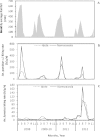Increasing role of Anopheles funestus and Anopheles arabiensis in malaria transmission in the Kilombero Valley, Tanzania
- PMID: 25150840
- PMCID: PMC4150941
- DOI: 10.1186/1475-2875-13-331
Increasing role of Anopheles funestus and Anopheles arabiensis in malaria transmission in the Kilombero Valley, Tanzania
Abstract
Background: In order to sustain the gains achieved by current malaria control strategies, robust surveillance systems that monitor dynamics of vectors and their roles in malaria transmission over time are essential. This longitudinal study demonstrates the trends in malaria vector dynamics and their relative contribution to malaria transmission in hyperendemic transmission settings in Tanzania.
Methods: The study was conducted in two villages within the Kilombero Valley, in rural Tanzania for five consecutive years (2008-2012). Seventy-two houses were selected per village and each house was sampled for mosquitoes monthly using a CDC light trap. Collected mosquitoes were assessed for species identity and sporozoite infection status using PCR and ELISA, respectively. Anopheles funestus and Anopheles arabiensis susceptibility to insecticides was assessed using WHO guidelines.
Results: A total of 100,810 malaria vectors were collected, of which 76% were Anopheles gambiae s. l. and 24% were An. funestus. Of all An. funestus samples that amplified with PCR (n = 2,737), 97% were An. funestus s.s., 2% were Anopheles rivorulum and 1% Anopheles leesoni. Whereas for An. gambiae s.l. (n = 8,117), 93% were An. arabiensis and 7% were Anopheles gambiae s.s. The proportion of An. gambiae s.s. identified by PCR (2,924) declined from 0.2% in the year 2008 to undetectable levels in 2012. Malaria transmission intensity significantly decreased from an EIR of 78.14 infectious bites/person/year in 2008 to 35 ib/p/yr in 2011 but rebounded to 226 ib/p/yr in 2012 coinciding with an increased role of An. funestus in malaria transmission. Insecticide susceptibility tests indicated high levels of resistance in An. funestus against deltamethrin (87%), permethrin (65%), lambda cyhalothrin (74%), bendiocarb (65%), and DDT (66%). Similarly, An. arabiensis showed insecticide resistance to deltamethrin (64%), permethrin (77%) and lambda cyhalothrin (42%) in 2014.
Conclusion: The results indicate the continuing role of An. arabiensis and the increasing importance of An. funestus in malaria transmission, and pyrethroid resistance development in both species. Complementary vector control and surveillance tools are needed that target the ecology, behaviour and insecticide resistance management of these vector species, in order to preserve the efficacy of LLINs.
Figures



References
-
- WHO . World Malaria Report. Geneva, Switzerland: World Health Organization; 2013.
-
- Tanzania Commission for AIDS ZAC, National Bureau of Statistics, Office of the Chief Government Statistician, ICF International Calverton MU . Tanzania HIV/AIDS and Malaria Indicator Survey 2011–12. Tanzania: Dar es Salaam: TACAIDS, ZAC, NBS, OCGS, and Macro International Inc Dar es Salaam; 2013.
-
- Bayoh MN, Mathias DK, Odiere MR, Mutuku FM, Kamau L, Gimnig JE, Vulule JM, Hawley WA, Hamel MJ, Walker ED. Anopheles gambiae: historical population decline associated with regional distribution of insecticide-treated bed nets in western Nyanza Province. Kenya Malar J. 2010;9:62. doi: 10.1186/1475-2875-9-62. - DOI - PMC - PubMed
-
- Mwangangi JM, Mbogo CM, Orindi BO, Muturi EJ, Midega JT, Nzovu J, Gatakaa H, Githure J, Borgemeister C, Keating J. Shifts in malaria vector species composition and transmission dynamics along the Kenyan coast over the past 20 years. Malar J. 2013;12:13. doi: 10.1186/1475-2875-12-13. - DOI - PMC - PubMed
Publication types
MeSH terms
Substances
LinkOut - more resources
Full Text Sources
Other Literature Sources
Medical
Miscellaneous

